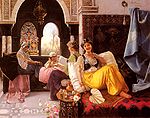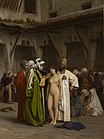Harem 내부의 사진촬영이 금지되어 있어 대신 자료로만 올립니다.
Harem


Harem (Turkish, from Arabic حرم ḥaram 'forbidden place; sacrosanct, sanctum', related to حريم ḥarīm 'a sacred inviolable place; female members of the family' and حرام ḥarām, 'forbidden; sacred') refers to the sphere of women in what is usually a polygynous household and their enclosed quarters which are forbidden to men. It originated in the Near East and came to the Western world via the Ottoman Empire.
Contents[hide] |
Etymology
The word has been recorded in the English language since 1634, via Turkish harem, from Arabic ḥaram 'forbidden', originally implying 'women's quarters', literally 'something forbidden or kept safe', from the root of ḥarama 'to be forbidden; to exclude'. The triliteral Ḥ-R-M is common to Arabic words denoting forbidden. The word is a cognate of Hebrew ḥerem, rendered in Greek as anathema when it applies to excommunication pronounced by the Jewish Sanhedrin court; all these words mean that an object is "sacred" or "accursed".
The 'harem' does not refer to a sanctuary for the wives of a polygynous person. It is simply a resting quarters for women.[citation needed] Female seclusion in Islam is emphasized to the extent that any unlawful breaking into that privacy is ḥarām "forbidden". A Muslim harem does not necessarily consist solely of women with whom the head of the household has sexual relations (wives and concubines), but also their young offspring, other female relatives, etc.; and it may either be a palatial complex, as in Romantic tales, in which case it includes staff (women and eunuchs), or simply their quarters, in the Ottoman tradition separated from the men's selamlık.[citation needed] The zenana was a comparable institution.[citation needed]
It is being more commonly acknowledged today that the purpose of harems during the Ottoman Empire was for the royal upbringing of the future wives of noble and royal men. These women would be educated so that they were ready to appear in public as a royal wife.[1]
History



The word harem is strictly applicable to Muslim households only, but the system was common, more or less, to most Oriental[clarification needed] communities, especially where polygyny was permitted.[2]
The Imperial Harem of the Ottoman sultan, which was also called seraglio in the West, typically housed several dozen women, including wives. It also housed the Sultan's mother, daughters and other female relatives, as well as eunuchs and slave servant girls to serve the aforementioned women. During the later periods, the sons of the Sultan also lived in the Harem until they were 16 years old, when it was considered appropriate for them to appear in the public and administrative areas of the palace. The Topkapı Harem was, in some senses, merely the private living quarters of the Sultan and his family, within the palace complex. Some women of Ottoman harem, especially wives, mothers and sisters of sultans played very important political roles in Ottoman history, and in times it was said that the empire was ruled from harem. Hürrem Sultan (wife of Süleyman The Magnificent, mother of Selim II) and Kösem Sultan (mother of Murad IV) were the two most powerful women in Ottoman history.
Moulay Ismail the Bloodthirsty, Alaouite sultan of Morocco from 1672 to 1727, is said to have fathered a total of 525 sons and 342 daughters by 1703 and achieved a 700th son in 1721.[3] He had over 500 concubines.[4]
Outside Islamic culture
Ancient Egyptian pharaohs are said to have made a "constant demand" of provincial governors for more beautiful servant girls.
In Mexico, Aztec ruler Montezuma II, who met Cortes, kept 4,000 concubines; every member of the Aztec nobility was supposed to have had as many consorts as he could afford.[5]
Harem is also the usual English translation of the Chinese language term hougong, 後宮 "the palaces behind." Hougong are large palaces for the Chinese emperor's consorts, concubines, female attendants and eunuchs. The women who lived in an emperor's hougong sometimes numbered in the thousands.
A similar institution existed among the Ōoku during the Edo period in Japan.[citation needed]
Depictions in contemporaneous Western culture
The institution of the harem exerted a certain fascination on the European imagination, especially during the Age of Romanticism (see also Orientalism), due in part to the writings of the adventurer Richard Francis Burton. Many Westerners imagined a harem as a brothel consisting of many sensual young women lying around pools with oiled bodies, with the sole purpose of pleasing the powerful man to whom they had given themselves. Much of this is recorded in art from that period, usually portraying groups of attractive women lounging nude by spas and pools.
A centuries-old theme in Western culture is the depiction of European women forcibly taken into Oriental harems - evident for example in the Mozart opera Die Entführung aus dem Serail ("The Abduction from the Seraglio") concerning the attempt of the hero Belmonte to rescue his beloved Konstanze from the seraglio/harem of the Pasha Selim; or in Voltaire's Candide, in chapter 12 of which the old woman relates her experiences of being sold into harems across the Ottoman Empire.
In popular culture
The same theme was and still is repeated in numerous historical novels and thrillers. For example, Angélique and the Sultan, part of the bestselling French Angélique series by Sergeanne Golon, in which a 17th century French noblewoman is captured by pirates, and sold into the harem of the King of Morocco.
In Leonid Solovyov's well-known Russian novel Tale of Hodja Nasreddin (translated to English as The Beggar in the Harem: Impudent Adventures in Old Bukhara), a central plot element is the protagonist's efforts to rescue his beloved from the Harem of the Emir of Bukhara - an element not present in the original tales of the Middle Eastern folk hero Nasreddin, on which the novel was loosely based.
H. Beam Piper used the theme in a science fiction context, portraying a gang which kidnaps girls from a Western-dominated, technologically advanced timeline and sells them to a Sultan's harem in an Asian-dominated timeline (see [1]).
Much of the plot of The Janissary Tree – a 2006 historical crime novel by Jason Goodwin, set in Istanbul in 1836 [6] – takes place in the Sultan's harem, with the main protagonist being the eunuch detective Yashim. The book in many ways seeks to overturn the above stereotypes and rooted conventions. For example, in one scene the Sultan groans inwardly when a new concubine is brought to his bed, since he does not feel sexual at all and would much rather send her away and curl up with a book. He does not, however, have that option; were he to reject the concubine, "she would spend the whole night crying bitterly, by the morning the whole palace will hear that the Sultan has become impotent, by noon all Istanbul will know it, and within a week the rumour will reach the entire empire."
Art
-
Terrace of the Seraglio, Jean-Léon Gérôme, 1824–1904, French
-
Shopping in the Harem, Rudolf Swoboda, 1859-1914, Austrian
-
Harem Scene, Quintana Olleras, 1851-1919, Spanish
-
Harem Pool, Jean-Léon Gérôme, 1824–1904, French
-
The Reception, John Frederick Lewis, 1805-1875, English
-
The Harem Fountain, Frederick Bridgeman, 1847-1928, American
-
Grande Odalisque, J.-A.-D. Ingres
-
Odalisque, Jules-Joseph Lefebvre
-
Im Harem (In the Harem), Carl Spitzweg
-
The Harem Servant, Paul Trouillebert, 1829-1900, French
-
The Slave Market, Jean-Léon Gérôme, c. 1884
-
A harem bathhouse, from manuscript of the Zanan Nameh by Fazil Yildiz, University of Istanbul.

















